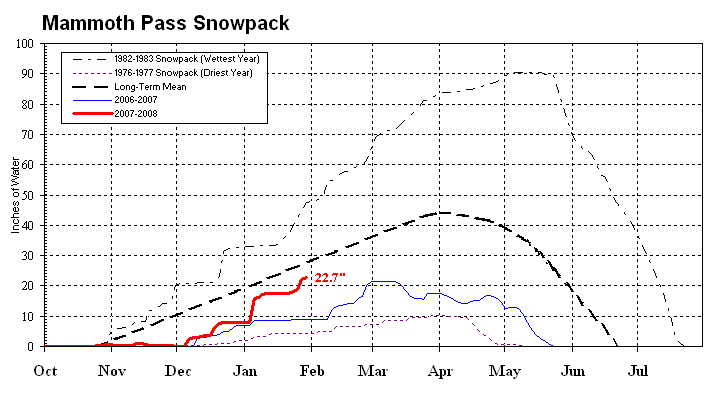

On Sunday mornings, Lisa and I lie in bed reading the paper and listening to the radio. Here's a nice radio essay on one of my all-time favorite pieces — Music for 18 Musicians by Steve Reich — and its award-winning new performance by an ensemble from Michigan:
If you like mysteries, this story has its own spooky charm:
Cellulosic ethanol could be better. Cellulose from many sources can be converted to ethanol, and this doesn't require using edible crops like corn: you could use waste wood chips from lumber, grasses that grow quickly just about anywhere, and so on. However, the production methods are still experimental: not very efficient, not ready to be scaled up:
Many researchers believe that the most promising way to make cellulosic biofuels economically competitive involves the creation — or the discovery — of "superbugs," micro÷rganisms that can break down cellulose to sugars and then ferment those sugars into ethanol. The idea is to take what is now a multistep process requiring the addition of costly enzymes and turn it into a simple, one-step process, referred to in the industry as consolidated bioprocessing. According to Lee Lynd, a professor of engineering at Dartmouth College and cofounder of Mascoma, a company based in Cambridge, MA, that is commercializing a version of the technology, the consolidated approach could eventually produce ethanol at 70 cents a gallon. "It would be a transformational breakthrough," he says. "There's no doubt it would be attractive."A more futuristic but perhaps ultimately better option: get bugs to convert cellulose and other stuff to hydrocarbons.But finding superbugs has proved difficult. For decades, scientists have known of bacteria that can degrade cellulose and also produce some ethanol. Yet none can do the job quickly and efficiently enough to be useful for large-scale manufacturing.
[...]
Susan Leschine, a microbiologist at the University of Massachusetts, Amherst, believes she just might have stumbled on a bug that will do the job. She found it in a soil sample collected more than a decade ago from the woods surrounding the Quabbin Reservoir, about 15 miles from her lab. The Quabbin sample was just one of many from around the world that Leschine was studying, so it was several years before she finished analyzing it. But when she did, she realized that one of its bacteria, Clostridium phytofermentans, had extraordinary properties. "It decomposes nearly all the components of the plant, and it forms ethanol as the main product," she says. "It produces prodigious amounts of ethanol."
Leschine founded a company in Amherst, SunEthanol, that will attempt to scale up ethanol production using the bacterium. There's "a long way to go," she acknowledges, but she adds that "what we have is very different, and that gives us a leg up. We already have a microbe and have demonstrated it on real feedstocks." Leschine says that other useful microbes are probably waiting to be discovered: a single soil sample, after all, contains hundred of thousands of varieties. "In this zoo of microbes," she says, "we can think that there are others with similar properties out there."
Second: there are lots of people here at UCR I'd enjoy meeting — but I'm so darn busy, I don't tend to go around knocking on doors. I just read about these folks in a UCR magazine:
Third: some Arabic music websites I keep meaning to check out:
Most prior studies have found that substituting biofuels for gasoline will reduce greenhouse gases because biofuels sequester carbon through the growth of the feedstock. These analyses have failed to count the carbon emissions that occur as farmers worldwide respond to higher prices and convert forest and grassland to new cropland to replace the grain (or cropland) diverted to biofuels. Using a worldwide agricultural model to estimate emissions from land use change, we found that corn-based ethanol, instead of producing a 20% savings, nearly doubles greenhouse emissions over 30 years and increases greenhouse gases for 167 years. Biofuels from switchgrass, if grown on U.S. corn lands, increase emissions by 50%. This result raises concerns about large biofuel mandates and highlights the value of using waste products.Alex Farrell of Berkeley says the biofuels industry needs a rapid switch of direction away from growing fuel towards using various forms waste: "We could replace all of the ethanol that we consume in California just using waste that goes to the landfill today, and turning that into ethanol."
Other suggest growing grass on lands that aren't suitable for
crops. This sounds like a great way to destroy what's left of
our wilderness.
February 9, 2008
I've been hard at work on my Rosetta
Stone paper with Mike Stay. But today is different - it's
our Lunar New Year party. We've invited 53 of our closest friends
and will get a bunch of them to work making jiaozi:
Unfortunately both Lisa and I have been under the weather with colds.
We'll try to shake 'em off tonight.
February 10, 2008
Great party! And, we're healthy now.
February 16, 2008
More people are beginning to realize that we're entering a new geological
epoch: the Anthropocene:
It looks like this epoch will be tough on the world's oceans:
Global warming and the acidification of the ocean due to increased CO2 are killing off coral reefs. Global warming and polluted runoff are causing the rapid spread of dead zones — patches of the ocean where the lack of oxygen kills all higher life forms.
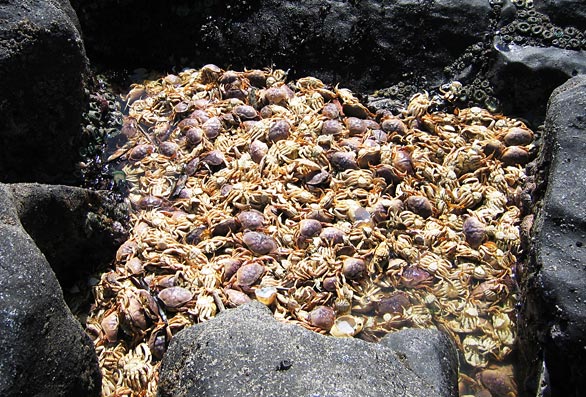
Peering into the murky depths, Jane Lubchenco searched for sea life, but all she saw were signs of death.Video images scanned from the seafloor revealed a boneyard of crab skeletons, dead fish and other marine life smothered under a white mat of bacteria. At times, the camera's unblinking eye revealed nothing at all — a barren undersea desert in waters renowned for their bounty of Dungeness crabs and fat rockfish.
"We couldn't believe our eyes," Lubchenco said, recalling her initial impression of the carnage brought about by oxygen-starved waters. "It was so overwhelming and depressing. It appeared that everything that couldn't swim or scuttle away had died."
Upon further study, Lubchenco and other marine ecologists at Oregon State University concluded that that the undersea plague appears to be a symptom of global warming. In a study released today in the journal Science, the researchers note how these low-oxygen waters have expanded north into Washington and crept south as far as the California state line. And, they appear to be as regular as the tides, a lethal cycle that has repeated itself every summer and fall since 2002.
"We seem to have crossed a tipping point," Lubchenco said. "Low-oxygen zones off the Northwest coast appear to be the new normal."
Yet another deadly blow to the oceans comes from overfishing. Many species of large fish are headed for extinction. For example, bluefin tuna in the Atlantic are down 97% since the start of long-line fishing in the 1980s. White marlin are down 94%. And so on.
What can you do? First: vote for politicians who seriously care about the Earth, not just the smaller problems that distract us so. Second: only buy seafood from sustainable sources! Find out what's good and what's bad. The sustainable seafood movement is already having an effect.
The seafood you should never eat:
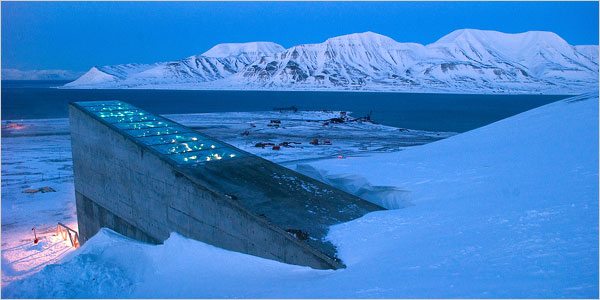
Near Arctic, Seed Vault Is a Fort Knox of Food
Elisabeth Rosenthal
New York Times, February 29, 2008
Longyearbyen, Norway - With plant species disappearing at an alarming rate, scientists and governments are creating a global network of plant banks to store seeds and sprouts, precious genetic resources that may be needed for man to adapt the world.s food supply to climate change.
This week, the flagship of that effort, the Global Seed Vault near here, received its first seeds, millions of them. Bored into the middle of a frozen Arctic mountain topped with snow, the vault.s goal is to store and protect samples of every type of seed from every seed collection in the world.
As of Thursday, thousands of neatly stacked and labeled gray boxes of seeds — peas from Nigeria, corn from Mexico — reside in this glazed cavelike structure, forming a sort of backup hard drive, in case natural disasters or human errors erase the seeds from the outside world.
Descending almost 500 feet under the permafrost, the entrance tunnel to the seed vault is designed to withstand bomb blasts and earthquakes. An automated digital monitoring system controls temperature and provides security akin to a missile silo or Fort Knox. No one person has all the codes for entrance.
The Global Vault is part of a broader effort to gather and systematize information about plants and their genes, which climate change experts say may indeed prove more valuable than gold. In Leuven, Belgium, scientists are scouring the world for banana samples and preserving their shoots in liquid nitrogen before they become extinct. A similar effort is under way in France on coffee plants. A number of plants, most from the tropics, do not produce seeds that can be stored.
For years, a hodgepodge network of seed banks has been amassing seed and shoot collections in a haphazard manner. Labs in Mexico banked corn species. Those in Nigeria banked cassava. Now these scattershot efforts are being urgently consolidated and systematized, in part because of better technology to preserve plant genes and in part because of the rising alarm about climate change and its impact on world food production.
"We started thinking about this post-9/11 and on the heels of Hurricane Katrina," said Cary Fowler, president of the Global Crop Diversity Trust, a nonprofit group that runs the vault. "Everyone was saying, why didn't anyone prepare for a hurricane before? We knew it was going to happen."
"Well, we are losing biodiversity every day — it's a kind of drip, drip, drip. It's also inevitable. We need to do something about it."
This week the urgency of the problem was underscored as wheat prices rose to record highs and wheat stores dropped to the lowest level in 35 years. A series of droughts and new diseases cut wheat production in many parts of the world. "The erosion of plants' genetic resources is really going fast," said Dr. Rony Swennen, head of the division of crop biotechnology at the Catholic University of Leuven in Belgium, who has preserved half of the world's 1,200 banana types. "We're at a critical moment and if we don't act fast, we're going to lose a lot of plants that we may need."
The United Nations International Treaty on Plant Genetic Resources, ratified in 2004, created a formal global network for banking and sharing seeds, as well as for studying their genetic traits. Last year, its database received thousands of new seeds.
A system of plant banks could be crucial in responding to climate crises since it could identify genetic material and plant strains better able to cope with a changed environment.
Here at the Global Vault, hundreds of gray boxes containing seeds from places ranging from Syria to Mexico were moved this week into a freezing vault to be placed in suspended animation. They harbor a vast range of qualities, like the ability to withstand drier, warmer climate.
Climate change is expected to bring new weather stresses, as well as new plant pests into agricultural regions. Heat-trapping carbon dioxide emissions will produce not just global warming but an increase in extreme weather events, like floods and droughts, the Intergovernmental Panel on Climate Change concluded.
Already three-quarters of biodiversity in crops has been lost in the last century, according to the United Nations Food and Agriculture Organization. Eighty percent of maize types that existed in the 1930s are gone, for example. In the United States, 94 percent of peas are no longer grown.
February 29, 2008
It's been raining a lot this month!
It's nice to see how the snowpack in the Sierras is
doing - especially compared to last year:
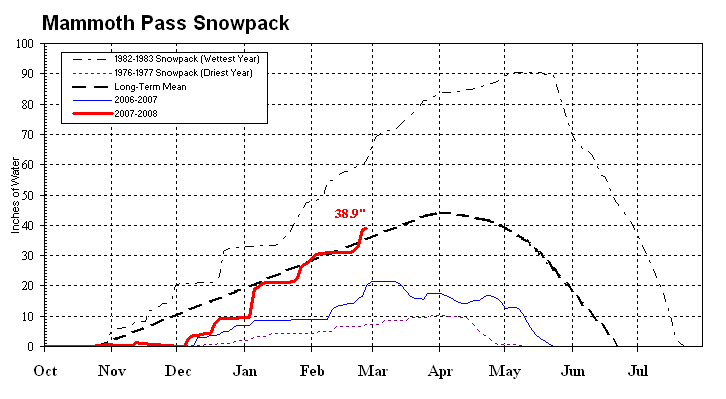
But on January 1st, a mandatory 30% water reduction hit many California farmers who had signed up for a program that gave them discounted water in exchange for being first in line when cutbacks were necessary. So, avocado growers in southern California are 'stumping' hundreds of trees to save water:
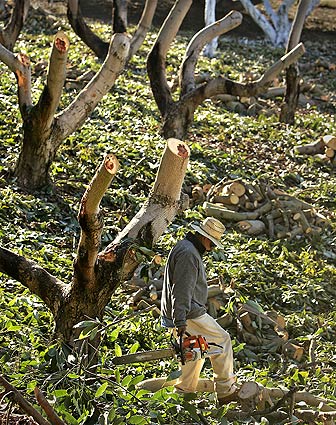
I think this 'stumping' doesn't kill the trees, but only renders them dormant... but I'm not sure: it looks pretty brutal. While the gardener in me hates to see this happen to any tree, water-intensive agriculture is really not the right way to use land in southern California. We need to face reality: too many people, not enough water — and a growing chance of drought thanks to global warming, while the population grows.
Some water facts from the Environmental Protection Agency:
Another idea is to recycle greywater: the somewhat dirty water produced by washing dishes, laundry and bathing. In principle this is an idea that could be adopted one household at a time, using systems like the one marketed by Ecoplay. Again, I don't understand the economics.
The real trick would be to make this subject seem as fascinating to young scientists as biotech or computer science.
If society wishes to avoid catastrophic disruption of our lives, the time for action is now. - Jane Lubchenko
© 2008 John Baez
baez@math.removethis.ucr.andthis.edu